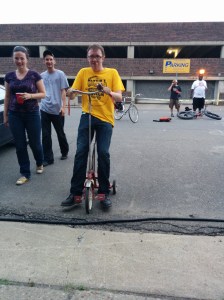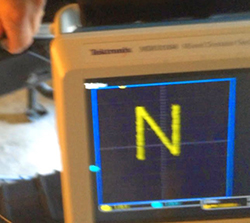Epic Party.
I don’t use that label lightly. After the Red Bull Creation’s day of show and tell was over — winners having been presented with trophies and stuffed with barbecue over at Bert’s — people started to trickle into OmniCorp Detroit for the party.
Like all of the best parties we didn’t really see it coming. I grabbed a folding chair on the street out front with a beer in my hand and enjoyed a rotating variety of interesting people to talk with.  [Brian] rolled up riding one of the trophies, a modified toddler’s tricycle that proves his future with a travelling circuit is still viable. They roped off the area and set up huge speakers for the DJ. Then two guys game lumbering down the street sharing the work of hauling a tub full of ice and 12-ounce clear glass bottles with colored liquid inside. Turns out they just opened a distillery down the street and decided to donate some vodka infusions for the festivities. Yum!
[Brian] rolled up riding one of the trophies, a modified toddler’s tricycle that proves his future with a travelling circuit is still viable. They roped off the area and set up huge speakers for the DJ. Then two guys game lumbering down the street sharing the work of hauling a tub full of ice and 12-ounce clear glass bottles with colored liquid inside. Turns out they just opened a distillery down the street and decided to donate some vodka infusions for the festivities. Yum!
Upstairs, a couple hundred square feet of area was ringed by a bar (with wide variety of kegs, slushy drinks, and one of those hot dog rollers), couches, a few work benches, a second DJ booth, and a photobooth. We only got one picture before the smoke machine reduced visibility.
Unlike a lot of ragers I’ve been at, it was easy to start up a conversation with just about anyone. Living expenses are so low in Detroit and artists are flocking to the area. This is who made up most of the group. Fascinating people who are working on a multitude of different projects and have stories of building community on their streets while rehabbing houses that cost $1-2.5k to purchase but didn’t come with most of what you’d assume a house should.
Then the fire dragon showed up
Inside was packed and outside was starting to get crowded. Then the fire dragon showed up. Named Gon KiRin, it’s the collaboration between [Teddy Lo] and [Ryan C. Doyle] who was on Team Detroitus and is artist in residence at Recycle Here!, the build venue for the Red Bull Creation.  The beast is built on the frame of a 1960’s dump truck and most of the building materials were found on the sides of the highway. The huge propane tank on the back allows it to breathe fire. I love that three daisy-chained 9-volts and two bare wires are the control mechanism for this. One thing became readily apparent; you don’t stand in front of Gon KiRin while it’s breathing fire.
The beast is built on the frame of a 1960’s dump truck and most of the building materials were found on the sides of the highway. The huge propane tank on the back allows it to breathe fire. I love that three daisy-chained 9-volts and two bare wires are the control mechanism for this. One thing became readily apparent; you don’t stand in front of Gon KiRin while it’s breathing fire.
The crowd piled onto the couches on top of the tail and at either rear hip. The dragons back also bore a continually rotating set of people. After midnight the guests really started to flood in. [Caleb] and I tried to close down the party but a few hours after midnight it didn’t seem to be getting any slower.
Capping off the weekend like this really proves that you need to get your team into next year’s Red Bull Creation. I got in the easy way — judges don’t have to stay up for 72 hours building stuff. Despite the sleep deprivation for contestants I didn’t come across anyone who wasn’t having a blast during the build, while goofing off, or trying to stay awake as this party got moving.
Bravo Detroit, you’re now on my short list of best party towns. Who else wants to be added to that list? Hackaday’s going to be in Las Vegas for DEFCON in a few weeks. Anyone know of parties planned that weekend and how we can get in?

















 A few years ago, [Pat] sent in
A few years ago, [Pat] sent in 











